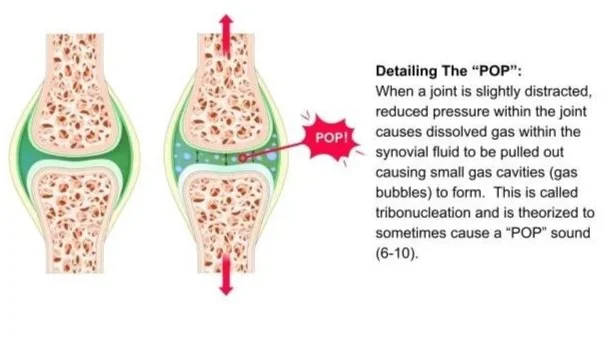What is the “POP” Sound During a Chiropractic Adjustment?
The Iconic “POP”
I’m often asked this question by first time patients, but perhaps just as often by patients who have experienced the benefits of a chiropractic adjustment many times. It is not necessary to hear a “POP” for an adjustment to be successful and the adjustment is far from the only tool that chiropractors use to promote healing and optimize health (1-6). Still, I don’t think it would be an exaggeration to say that an audible “POP” during a chiropractic adjustment is iconic of the profession, especially since the arrival of YouTube and other social media platforms. In my experience, the adjustment and the sound that it can create is often misunderstood or misrepresented. This blog post will focus on explaining the most widely accepted evidence based theory for the “POP” sound (6-10). I’m hoping this will bring the reader a better understanding and even an appreciation of the mechanism. Evidence for the wide range of health benefits of the chiropractic adjustment will be presented in future posts.
An Analogy
Imagine putting a small amount of water on a panel of glass and lightly placing another panel on top. The two panels of glass would glide across each other smoothly, using the water as a lubricant. Now imagine pressing the two panels together. This would increase the surface area of the water essentially increasing the surface tension and adhesion. This suction effect creates a vacuum-like seal making it difficult to glide the glass panels across each other. They would feel stiff or stuck. Now imagine pulling the two panels of glass apart. You might hear a “POP” as the surface tension releases. If you lightly place the two glass panels back together, they would recover their ability to glide across each other with ease.
Synovial Joint
The glass panels with water between them is comparable to the synovial joints in our body. Synovial joints have two smooth surfaces with a lubricant between them called synovial fluid. The two surfaces should glide freely across each other allowing for body movement. Joints can be compressed from muscle tension, gravity or loading over time, making them feel stiff or stuck. During certain types of chiropractic adjustments, the joint surfaces are slightly distracted. This often (but not always) creates a “POP” sound. Similar to the two panels of glass, the adhesion or fixation is released. This allows the two joint surfaces to glide across each other with greater ease. Whether the “POP” sound is heard or not, it is often immediately apparent (to both the practitioner and the patient) that the motion of the joint has increased after the adjustment (11,12).
Joints Can Feel
Unlike the glass panels, synovial joints have mechanoreceptors and nociceptors (nerve endings that relay movement and pain) in and around them. This is why many patients describe a feeling of immediate pressure, tension, or pain relief after an adjustment (11,12). To do this safely and with therapeutic or performance benefits requires a skilled practitioner who is willing to take the time to do a thorough history and exam. How a chiropractor decides where or if a particular adjustment should be performed is a discussion for a future post.
Dr. Kent practices Chiropractic Medicine at Tribalance Wellness combining health philosophies from the East and West to create specific and unique treatments for each patient. Make your appointment to see him today!
References:
1. Flynn TW, Fritz JM, Wainner RS, Whitman JM. The audible pop is not necessary for successful spinal high-velocity thrust manipulation in individuals with low back pain. Archives of physical medicine and rehabilitation. 2003 Jul 1;84(7):1057-60.2. Bialosky JE, Bishop MD, Robinson ME, George SZ. The relationship of the audible pop to hypoalgesia associated with high-velocity, low-amplitude thrust manipulation: a secondary analysis of an experimental study in pain-free participants. Journal of manipulative and physiological therapeutics. 2010 Feb 1;33(2):117-24.3. Sillevis R, Cleland J. Immediate effects of the audible pop from a thoracic spine thrust manipulation on the autonomic nervous system and pain: a secondary analysis of a randomized clinical trial. Journal of manipulative and physiological therapeutics. 2011 Jan 1;34(1):37-45.4. Cleland JA, Flynn TW, Childs JD, Eberhart S. The audible pop from thoracic spine thrust manipulation and its relation to short-term outcomes in patients with neck pain. Journal of manual & manipulative therapy. 2007 Jul 1;15(3):143-54.5. Flynn TW, Childs JD, Fritz JM. The audible pop from high-velocity thrust manipulation and outcome in individuals with low back pain. Journal of manipulative and physiological therapeutics. 2006 Jan 1;29(1):40-5. Link6. Moorman AC, Newell D. Impact of audible pops associated with spinal manipulation on perceived pain: a systematic review. Chiropractic & manual therapies. 2022 Dec;30(1):1-1.7. Kawchuk GN, Fryer J, Jaremko JL, Zeng H, Rowe L, Thompson R. Real-time visualization of joint cavitation. PloS one. 2015 Apr 15;10(4):e0119470.8. Bergamino M, Vongher A, Mourad F, Dunning J, Rossettini G, Palladino M, Fernández-de-Las-Peñas C, Testa M, Maselli F. Patient concerns and beliefs related to audible popping sound and the effectiveness of manipulation: findings from an online survey. Journal of Manipulative and Physiological Therapeutics. 2022 Feb 1;45(2):144-52.9. Roston JB, Haines RW. Cracking in the metacarpo-phalangeal joint. Journal of anatomy. 1947 Apr;81(Pt 2):165.10. Brodeur R. The audible release associated with joint manipulation. Journal of manipulative and physiological therapeutics. 1995 Mar 1;18(3):155-64.11. Martínez-Segura, Raquel & Fernández-de-Las-Peñas, César & Ruiz-Sáez, Mariana & López-Jiménez, Cristina & Rodriguez-Blanco, Cleofas. (2006). Immediate Effects on Neck Pain and Active Range of Motion After a Single Cervical High-Velocity Low-Amplitude Manipulation in Subjects Presenting with Mechanical Neck Pain: A Randomized Controlled Trial. Journal of manipulative and physiological therapeutics. 29. 511-7. 10.1016/j.jmpt.2006.06.02212. Triano JJ. Studies on the biomechanical effect of a spinal adjustment. Journal of manipulative and physiological therapeutics. 1992 Jan 1;15(1):71-5. Link 


